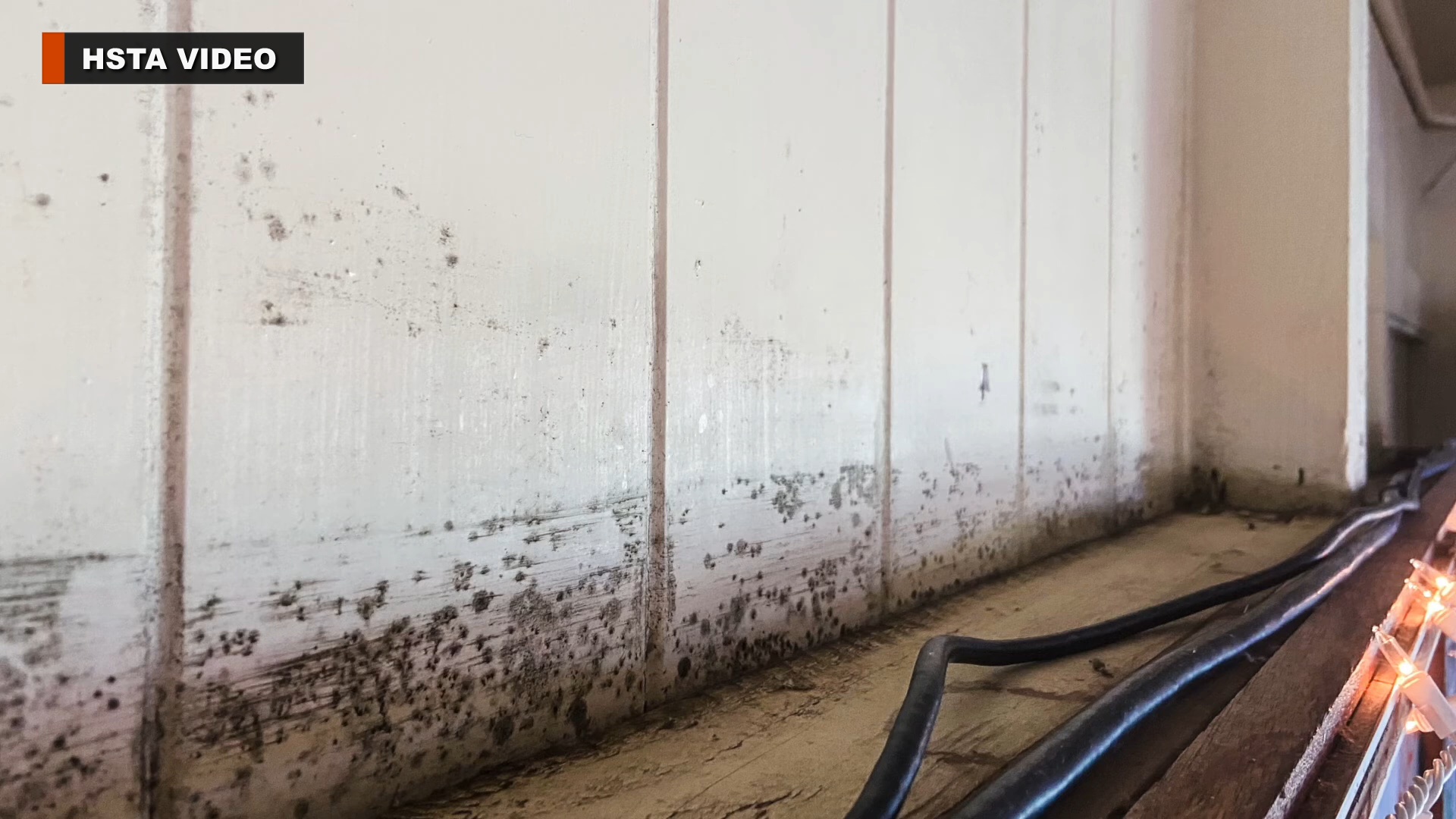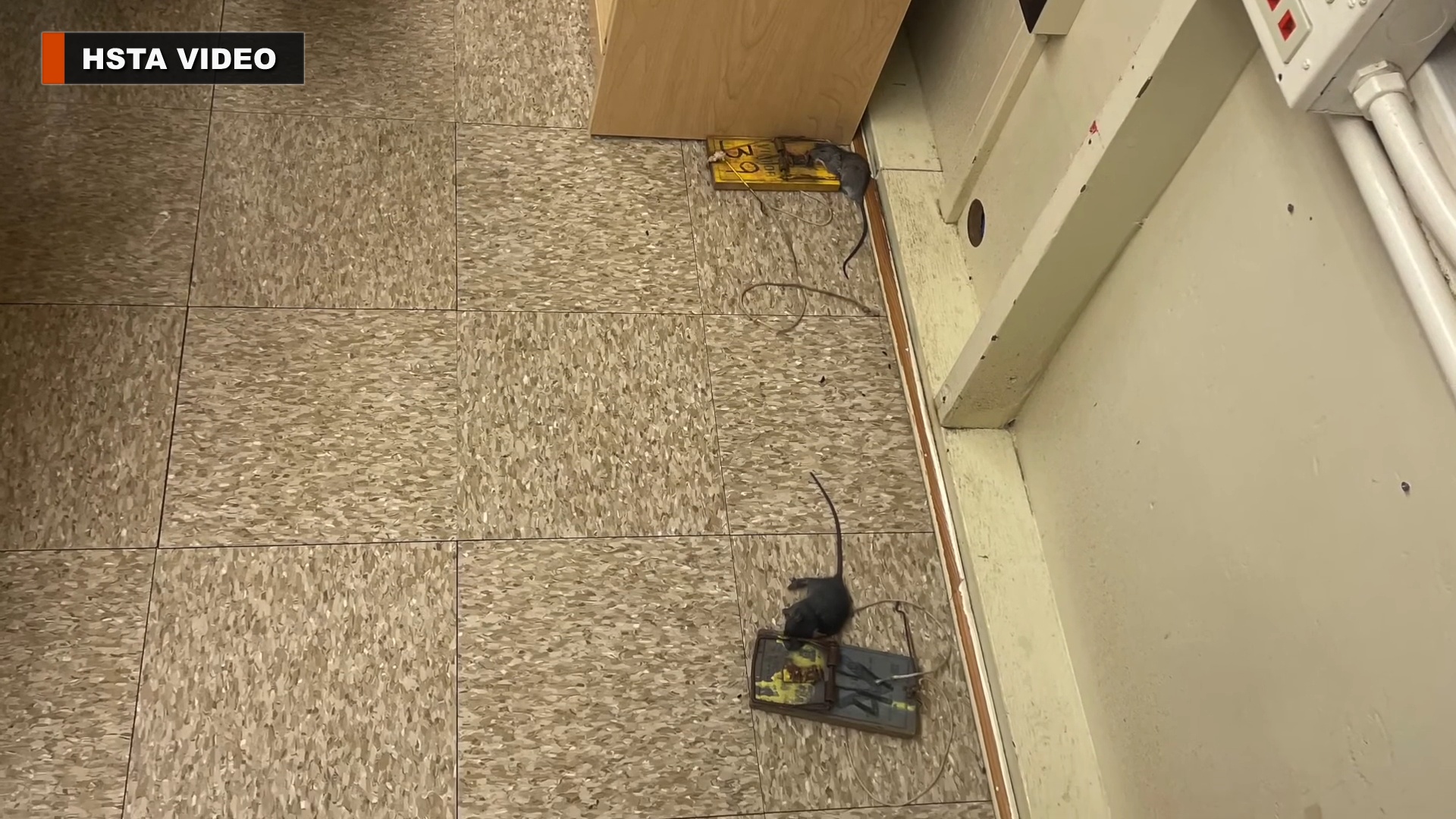(BIVN) – Conditions at a Kona school that have teachers and parents concerned for the health of students and staff were detailed Monday during a news conference organized by the Hawaiʻi State Teachers Association.
“Thank you for joining us for this news conference about persistent problems with mold, structural damage, termites, rats and other maintenance difficulties at Hōlualoa Elementary School on Hawaii Island,” said Logan Okita, the vice president of the Hawaii State Teachers Association, speaking to media by video conference. “Hōlualua Elementary was founded in 1895. It has close to 500 students and about 50 faculty and staff. And in spite of the best efforts by its principal, faculty, custodial staff and parents, the state has continually failed to maintain the campus while underlying problems at the school persist and get even worse. Let’s take a look at some of them now.”
The biggest problem throughout the Hōlualoa Elementary campus is mold. Teachers say mold like this appears on the walls and the ceilings of many classrooms, especially when the school is closed for a week or more during school breaks.
While custodians do their best to clean the mold, teachers say it persists all over… from the ceiling of the school office… to closet doors inside classrooms, and the covered walkways around campus.
Students haven’t been able to use the library since late last year because a first-grade class had to temporarily relocate into the library due to persistent mold problems in their classroom.
Teachers say in November, the principal asked for professional cleaning of the classrooms to help eradicate mold… but months later … it’s still unclear when that will happen.
Teachers say several staff tested positive for mold in their lungs and doctors have told them not to return to the school into offices and classrooms affected by mold. Teachers report students have high absentee rates because of respiratory problems.
The carpeting in some classrooms is many years old, stained and in poor condition. You can see portions are held together with duct tape. The state plans to remove these old carpets which likely are a breeding place for mold underneath, and there are concerns that tearing out the carpets might expose hazardous asbestos in some of these old buildings.
The state told teachers it plans to remove carpeting and repaint classrooms affected by mold. But the renovations will continue through the spring and summer breaks, meaning a fix is months away at best. They have been told that the carpets would be removed for the last three years, but they’re still in place.
The school just received these humidifiers on February 9th for every classroom. Staff were instructed to close the windows every night, and turn on the dehumidifiers and then empty them out every morning before school.
There are many other problems, like this paint containing lead that’s peeling off the ceiling of a third-grade classroom… so the students and teacher here relocated to a stage in the cafeteria for weeks and more recently moved into a computer lab.
The largest student public restroom on campus was closed in January over concerns about its structural integrity. Look at the exposed rusted rebar in the outside corner of the building with cracked, rotted concrete. Recently, state structural engineers inspected the building and deemed it safe to reopen but longer-term repairs are still needed. Parents and faculty still feel the restroom is unsafe for use.
Termite damage is pervasive throughout the older buildings on campus and that may contribute to potential problems with buildings’ foundations. Some supports to buildings have appeared to move off their pylons… a problem that may be exacerbated by volcanic earthquakes on the Kona side of Hawaii Island.
Rats are also a problem here … traps killed two rats in a classroom just a few weeks ago. Educators have found rat droppings on classroom materials… and the rats have chewed right through some books and other publications. Staff say rats crawl up and down this tubing in the English learners’ classroom through a hole in the ceiling. They also chewed their way through fiber cable wires last month… knocking out the internet and phone service on campus. And rats chewed up a pair of a teacher’s sandals left overnight in a classroom… leaving them ravaged.
Then there’s this aging road that runs right through campus. Elementary students have to cross every day to go to the restroom, the cafeteria or two playgrounds, putting them at risk of getting hit by a vehicle. From the air, you can see how the problem evolved. The original school was built on the right side of the road, but the campus expanded over the years and numerous portable classrooms were constructed on the left side of the road.
“Hōlualoa Elementary is one of the oldest schools in the state,” added Okita, “and we should be taking better care of it because it’s falling apart, putting students and educators at risk of illness and injury.”
“HSTA’s primary goal here is to obtain clarity from the state,” Okita said. “We want a plan to address the situation, including at the very least… an outline of which repair, maintenance and other projects will be completed and when. We want to reiterate that the principal has been strongly advocating for improvements at the school and the custodial staff has done its best to keep things clean.”
The news conference was then turned over to select teachers and parents, who detailed their experiences with the situation at the Kona school.
“People started getting very sick in my room, teachers that came for lunch – one went to the hospital for two weeks, and this was 2002,” said Lisa Vail, a Student Services Coordinator at the school. “I had chronic bronchitis, sinusitis, so I filed a grievance against for unsafe working conditions and they brought in a professional mold company back in 2002. It eradicated the mold and then a state inspector came and deemed that room uninhabitable, and that was way back when.”
After getting moved to a new building down by the cafeteria due to her room being uninhabitable by a state inspector, Student Services Coordinator Lisa Vail says, she ended up in a “rat infested” room. “They called vector control, they did everything they could,” Vail said, but “the hole is still there and the rats still crawl up and down.”
“To me, it’s just unacceptable. We got the babies here. We’re on the Big Island. They grew up in vog. They’re already compromised. So many of them are out on respiratory illnesses. Staff started getting sick. It’s unacceptable. Something needs to be done and I’m not going anywhere until it does.”
“Most recently, due into an invasive mold condition in my classroom, my students and I were displaced to the school library,” said 1st Grade Teacher Courtney D’Agostino. “Sadly, the library has even higher mold counts than on my former classroom, and I know this firsthand because I have paid out of my own pocket for mold-testing.”
“My own health has been severely impacted over the past six months. I’ve been in and out on medical leave,” D’Agostino said. “Friday was my last day on campus for a while, it’s for an extended time. I’m not sure when I’ll be back. I’ve missed a lot of school, and that leaves me not teaching our keiki. That leaves them in other people’s hands. And while we have great subs on campus, this is my profession and I do what I do for our keiki.”
“I had to make a decision and request a change, because they they are refusing to begin any type of cleaning in the classroom,” said Jennifer Gillette, the parent of a Hōlualoa student. “I had to make a decision to move my own child out of what should have been a his last year at Hōlualoa.”
“In my interactions with the DOE, I found it lacked transparency,” Sarah Teehee, a Hōlualoa Elementary parent who is also the Vice President of the Parent-Teacher Organization and a School Community Council member. “There was a lack of a sense of urgency, and I did not feel that caring connection that I want to feel when I’m talking to someone who is in a position of power who can make choices about the health and safety of students and staff.”
While the short-term solution is professional cleaning, Vail said, the long-term solution is a new school. “We’ve known that forever,” Vail explained. “I’m on my 15th principle. We have three master plans in the books that have never been funded by the legislature.”



by Big Island Video News5:07 pm
on at
STORY SUMMARY
KONA, Hawaiʻi - The HSTA held a news conference to talk about the "persistent problems with mold, structural damage, termites, rats and other maintenance difficulties" at Hōlualoa Elementary School.